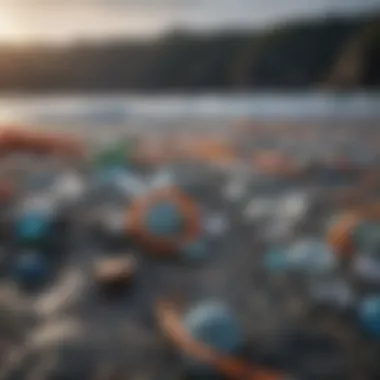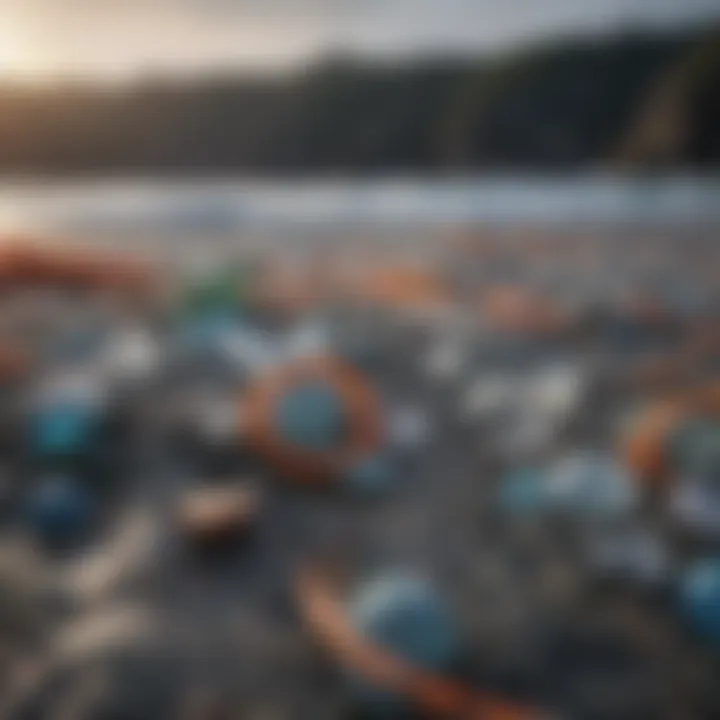Unveiling the Plastic Islands of the Pacific


Intro
Plastic pollution is a global crisis with far-reaching implications, especially evident in the Pacific Ocean. This area has become infamous for its plastic islands, which are not mere curiosities but significant environmental challenges. In recent decades, plastic debris has accumulated due to various factors, including consumer habits, inadequate waste management, and the durability of plastic materials. This article examines these islands, focusing on their origins, composition, and the impact they have on marine life and human health.
Understanding this phenomenon is crucial, as it reflects broader trends in consumption and environmental degradation. Marine ecosystems are suffering from the ingestion of microplastics, which are tiny plastic particles that result from larger plastic debris disintegrating. These issues are interconnected with human health concerns as microplastics find their way into our food chain.
By exploring the factors leading to the formation of plastic islands, alongside potential initiatives to mitigate their growth, this article aims to provide a comprehensive overview of this pressing issue.
Research Overview
Summary of Key Findings
Research reveals alarming statistics about plastic pollution in the Pacific. Large areas contain concentrations of plastic up to 1.5 million pieces per square kilometer. The Great Pacific Garbage Patch has gained particular attention, consisting chiefly of discarded plastic items that do not biodegrade. Studies show that about 80% of ocean plastic originates from land-based sources, a figure that underscores the connection between terrestrial waste management and ocean health.
- Composition: Most of the plastic found is made from discarded fishing gear, food wrappers, and bottle caps.
- Ecosystem Impact: Marine species face threats from entanglement and ingestion, leading to altered feeding behaviors and reproductive issues.
- Human Health: Microplastics contaminate seafood, raising concerns about potential health risks when consumed.
„The ocean is a silent witness of our consumption habits and negligence, echoing the call for decisive action.”
Relevance to Current Scientific Discussions
The topic of plastic islands has prompted significant discourse among scientists, environmentalists, and policymakers. Recent discussions focus on the effectiveness of current legislative measures and grassroots efforts aimed at curbing plastic waste. This issue is particularly relevant given the ongoing debate about climate change and sustainability. The dynamics of pollution in oceanic regions directly relate to global warming patterns, highlighting the need for comprehensive studies.
The scientific community increasingly emphasizes interdisciplinary approaches combining environmental science, social behavior analysis, and policy research. Understanding the origins and effects of plastic pollution not only contributes to effective mitigation strategies but also informs public awareness efforts.
Methodology
Research Design and Approach
The approach taken in studying plastic islands involves both qualitative and quantitative methods. Researchers use satellite imagery to map the distribution of plastic debris and combine this data with oceanographic models to understand movement patterns. Field studies include direct sampling of water and marine life, allowing for detailed analysis of plastic composition and its effects on ecosystems.
Data Collection and Analysis Techniques
Several techniques are employed to collect and analyze data related to plastic pollution:
- Remote Sensing: Satellite imagery aids in visualizing areas heavily impacted by plastic waste.
- In-Situ Sampling: Physical collection of water samples helps assess the density and type of plastic present.
- Laboratory Analysis: Chemical analysis is performed to identify the composition of plastics found within marine organisms.
In summary, the research endeavors to shed light on the extent and ramifications of plastic islands in the Pacific Ocean, driving home the urgency of mitigating actions that can be adopted at various levels, from individual choices to global initiatives.
Foreword to Plastic Pollution
Plastic pollution is an urgent issue that has garnered significant attention in recent years. The proliferation of plastics in oceans poses a grave threat to marine ecosystems, wildlife, and potentially human health. Understanding the roots of this environmental crisis is essential for developing strategies to mitigate its impacts. The complexity of plastic pollution stems from its origins, types, and interactions with the environment. This section elaborates on the definition and historical context of plastic pollution, setting the stage for deeper explorations of its implications and solutions.
Definition of Plastic Pollution
Plastic pollution can be defined as the accumulation of plastic products in the environment that adversely affects wildlife and habitat. It is not just about visible waste, like plastic bags or bottles, but also includes microplastics—tiny particles resulting from the fragmentation of larger plastic items, often measuring less than five millimeters. These particles infiltrate ecosystems at an alarming rate, impacting marine life, subsequently entering food chains, and even affecting human health.
Historical Context
To understand the current state of plastic pollution, it is essential to look at its historical context. Plastic was first developed in the early 20th century, becoming widespread due to its durability and versatility. Post-World War II, production rates soared, with single-use plastics becoming commonplace by the 1970s. While this innovation brought many conveniences, it also led to unsustainable practices regarding waste management.
In the 1990s, scientists began to recognize the alarming accumulation of plastics in oceans, giving rise to research and advocacy around marine litter. The rise of the Great Pacific Garbage Patch, a dense area of plastic debris in the North Pacific Ocean, underscored the severity of the issue.
This section outlines the breadth of the situation, providing a foundation for discussions in subsequent sections. The growing concern for marine health prompted global calls for change, leading to international agreements and grassroots movements aimed at combating plastic pollution.
"As plastic production and consumption continue to climb, the responsibility falls on all of us to reconsider our habits and the impact they have on our planet."
Awareness has grown, but it is still critical to delve deeper into the mechanisms behind plastic accumulation in our oceans.
The Pacific Ocean: A Global Perspective
The Pacific Ocean, the largest and deepest ocean on Earth, plays a critical role in our planet's climate system, ecology, and economies. Understanding this immense body of water is essential when examining the phenomenon of plastic pollution, particularly the plastic islands forming within it. The ocean not only serves as a vital resource for human activities but also supports a vast array of marine life. Inadequate management of our plastic waste directly impacts this ecosystem and, therefore, affects global health and security.
Geographical Overview
The Pacific Ocean spans more than 63 million square miles and is home to some of the world’s most diverse marine environments. It is bounded by numerous countries and island nations, with varying coastlines that contribute to its ecological richness. Notably, this ocean contains several large gyres—rotating ocean currents that influence the distribution of materials, including plastics. For instance, the North Pacific Gyre traps debris and creates an area known as the Great Pacific Garbage Patch.
The geographical features of the Pacific, including its trenches, reefs, and islands, are molded by both tectonic activity and oceanic currents. The Marianas Trench, the deepest part of this ocean, provides a stark contrast to the coral reefs that flourish in its shallower areas. This vast difference in depth supports a wide range of biodiversity, which is now under threat from accumulating plastic debris.
Significance of the Pacific Ocean
The importance of the Pacific Ocean extends far beyond its sheer size. It regulates weather patterns, especially in the Asia-Pacific region, acting as a reservoir of heat and moisture. This influence can have both immediate and long-range effects on climate. For instance, phenomena such as El Niño profoundly affect global weather conditions and marine life cycles.
Furthermore, the Pacific is a critical trade route, facilitating the movement of goods and resources across continents. This economic significance brings with it an increased responsibility for managing pollution, particularly plastics that enter the ocean through rivers and coastal cities.


The rich resources that the Pacific Ocean provides, from fisheries to tourism, highlight the need for sustainable practices. The health of marine ecosystems is directly linked to human prosperity, making the issue of plastic islands not just an environmental concern but also a socio-economic one. As we delve deeper into understanding plastic pollution, it becomes evident that our responses must consider both ecological balance and human livelihoods to forge a path toward a sustainable future.
"The Pacific Ocean is not only the largest body of water on Earth, but it is also critical to the future of global ecosystems and economies."
In summary, the Pacific Ocean holds significant ecological, climatic, and economic weight, making it essential to guard against the growing threat of plastic pollution. Recognizing its importance is the first step toward a comprehensive understanding of how to engage with and address the challenges posed by plastic islands.
Formation of Plastic Islands
The formation of plastic islands is a critical topic when discussing plastic pollution in the Pacific Ocean. Understanding how these islands emerge sheds light on the broader issues of waste management and environmental degradation. The accumulation of plastic debris in our oceans has profound implications for marine ecosystems, human health, and the overall sustainability of our planet. By analyzing the processes that lead to the creation of these islands, we can better appreciate the need for effective mitigation strategies.
Mechanisms of Accumulation
Plastic islands form primarily through a combination of ocean currents, wind patterns, and human waste disposal practices. The major mechanisms include:
- Ocean Currents: Currents, such as the North Pacific Gyre, play a significant role in gathering plastic debris. The movement of water pulls floating trash into concentrated areas, leading to the formation of plastic islands.
- Wind Action: Wind patterns can also transport lightweight plastics across distances. They can be directed toward calm areas of water, further contributing to accumulation.
- Human Activity: Practices like improper waste disposal and inadequate recycling methods result in significant amounts of plastic entering our waterways. Storms and floods exacerbate this issue by washing debris directly into ocean systems.
Major Locations of Plastic Accumulation
Identifying the major locations of plastic accumulation is essential for understanding the scale of this environmental challenge.
Great Pacific Garbage Patch
The Great Pacific Garbage Patch is perhaps the most infamous site associated with plastic islands. Located between Hawaii and California, this area is a significant contributor to the global plastic pollution crisis. Its key characteristic is the sheer volume of debris, with estimates suggesting it consists of approximately 1.8 trillion pieces of plastic. This prominence makes it a crucial point of study for researchers.
One unique feature of the Great Pacific Garbage Patch is its composition. The bulk of plastic found here is microplastics, which are smaller than 5mm and can be easily ingested by marine life. The presence of these microplastics poses severe risks to animals on all levels of the food chain. Overall, its significance lies in the alarming rates of marine life affected by the pollution and the urgent need for intervention strategies.
Other Notable Sites
In addition to the Great Pacific Garbage Patch, there are several other sites worthy of mention. Areas like the South Pacific Gyre and the Indian Ocean Gyre also harbor significant quantities of plastic waste. One characteristic of these sites is that they often go unnoticed compared to the Great Pacific Garbage Patch, yet they contribute massively to global plastic pollution.
These lesser-known sites remind us that plastic pollution is a widespread issue, affecting multiple ocean basins. Their unique feature is that the plastic debris present may be more difficult to quantify due to less research and monitoring. This can lead to a lack of awareness and the need for improved data collection methods.
"The oceans are becoming the planet's plastic dumping ground, with devastating effects on marine life and ecosystems."
Efforts to address these sites are often limited by funding and political will, making them challenging yet crucial for future environmental policies.
Understanding these mechanisms and locations of plastic accumulation helps frame the conversation surrounding plastic pollution, revealing the urgent need for informed actions and policies.
Composition of Plastic Islands
Understanding the composition of plastic islands is crucial in addressing the broader issue of plastic pollution. These islands are not just simple accumulation of waste but a complex mix of various types of plastics and microplastics. Knowing what constitutes these islands helps in diagnosing the environmental impact and can guide effective mitigation strategies.
Types of Plastics Found
The plastic found in the Pacific islands varies significantly, comprising several types of materials. Many of these plastics are derived from consumer products, packaging, and industrial waste. Some common types include:
- Polyethylene: Used widely in bags, bottles, and containers. It is lightweight and can be resistant to degradation in marine environments.
- Polypropylene: Common in packaging, automotive components, and textiles. Its durability poses long-term environmental risks.
- Polystyrene: Found in disposable cups and food containers, it tends to break into small fragments, contributing to microplastic pollution.
These plastics often leach chemicals into the ocean, affecting marine life and potentially entering the human food chain.
Microplastics and Their Prevalence
Microplastics are small plastic pieces less than five millimeters in length. They originate from various sources, including the breakdown of larger plastic items or are intentionally manufactured as microbeads in personal care products. Their prevalence in plastic islands is alarming.
Microplastics are
- Ubiquitous in ocean environments, making their presence in the Pacific nearly guaranteed.
- Ingested by marine organisms, they have been found in fish, shellfish, and even in the ocean water itself.
- Disruptive to marine ecosystems. The ingestion of microplastics by marine life can cause physical and chemical harm, leading to a cascade of ecological consequences.
"Microplastics represent a critical component of the overall plastic pollution crisis, affecting both marine life and humans."
Addressing microplastics is vital for any long-term strategy to combat plastic pollution and safeguard marine biodiversity. Their persistence in the aquatic environment highlights the need for innovative solutions that go beyond traditional waste management practices.
Impact on Marine Ecosystems
The issue of plastic islands has profound implications on marine ecosystems. These ecosystems, which encompass all sea life varieties, face direct threats from the rising levels of pollution in our oceans. Understanding the impact of plastic pollution is essential for implementing effective conservation strategies, especially for species that are crucial to ocean health. The encroachment of plastic into these ecosystems disrupts natural resources and alters the viability of various organisms.
Threats to Marine Life
Entanglement
Entanglement is a significant problem associated with plastic pollution. Marine animals often become ensnared in discarded fishing nets, ropes, and other plastic materials. This poses an immediate risk to the lives of numerous species, particularly larger mammals like whales and seals. The key characteristic of entanglement is its unpredictability; marine creatures can suffer severe injuries or even death as they struggle to free themselves from the plastic traps. This is an important choice to highlight in this article as it illustrates the tangible, immediate dangers that plastic pollution imposes on marine biodiversity. It also serves as a stark reminder that what is often seen as waste continues to haunt and harm ocean life long after it has been discarded.
Ingestion Risks
Ingestion risks associated with plastic islands are alarming. Many marine organisms, especially smaller fish and invertebrates, mistake microplastics for food. This leads to digestive blockages, malnutrition, and even starvation. The main characteristic of ingestion risks is the insidious nature of microplastics; they are often not visible to the naked eye. Raising awareness of this issue is crucial, as the consequences not only affect individual species but can also have cascading effects through the food web. This creates bioaccumulation, where toxins build up in larger predators and potentially impact human health as well. Understanding the ingestion risks of plastics is vital for emphasizing the interconnectedness of marine life with human wellbeing in this article.


Ecosystem Disruption
Ecosystem disruption due to plastic pollution is a multifaceted concern. The presence of large debris can physically alter habitats, making them less suitable for diverse marine species. Additionally, the chemical composition of plastics can leach harmful substances into ocean waters. Biodiversity loss is a critical aspect of this disruption. With the decline of various species, ecosystems struggle to maintain balance, leading to large-scale declines in health and productivity. This article addresses biodiversity loss because it highlights the delicate interplay of species and their environments, underlining the potential for catastrophic changes if action is not taken.
Biodiversity Loss
Biodiversity loss fundamentally weakens the resilience of marine ecosystems. When numerous species decline or disappear, the functionality of the entire ecosystem is compromised. The ecosystems become less able to recover from disturbances such as climate change or natural disasters. This aspect is significant in our exploration of plastic islands as it points out not only the immediate effects on single species but the broader implications on ecosystem processes.
Habitat Alterations
Habitat alterations emerge as a result of the accumulation of plastics, which can change the physical characteristics of marine environments. For example, coral reefs can be smothered by plastic debris, leading to decreased light penetration and diminished habitat for marine life. Highlighting this issue assists in understanding how plastics can reshape marine landscapes, often destructively. The adverse effects of habitat alterations can ripple through marine environments, making this an essential focal point when discussing the impacts of plastic pollution.
"The extent of plastic pollution is not just an environmental concern; it's a complex issue that affects all levels of life."
By exploring the multifaceted impacts on marine ecosystems, this article aims to foster more profound comprehension of how plastic islands influence not only the ocean but ultimately our lives on land as well.
Human Health Concerns
The presence of plastic pollution in the Pacific Ocean raises significant concerns regarding human health. As these plastic islands grow, they not only affect marine life but also pose risks to humans, primarily through the food chain and direct exposure. Understanding the human health implications of plastic pollution is essential for addressing this pressing environmental issue. It is vital to recognize how microplastics and the contamination of food sources can affect health outcomes.
Toxicity of Microplastics
Microplastics, defined as small plastic particles less than five millimeters in size, can be found throughout the Pacific Ocean. Their pervasive nature in marine environments means they often end up in the foods humans consume, such as seafood. Microplastics are capable of absorbing harmful chemicals and toxins from their surrounding environment. This capacity raises concerns about the toxicity of microplastics.
Research suggests that when ingested, microplastics may release these absorbed toxins into the human body. Some of these chemicals are known to be endocrine disruptors, potentially leading to hormonal imbalances, reproductive issues, and even cancer. Studies on various marine species have shown that toxicity levels can accumulate as these organisms feed on microplastics, making it crucial for humans to consider the health risks associated with consuming seafood contaminated with these particles.
Implications for Food Safety
The relationship between plastic pollution and food safety cannot be overstated. As microplastics infiltrate marine food webs, they have the potential to impact food safety on a global scale. When fish and shellfish ingest microplastics, these particles are not just a physical contaminant; they can also affect the quality of the seafood.
Moreover, people unable to see or taste microplastics will consume contaminated seafood unknowingly. This unawareness can lead to long-term health implications. Here are a few points to consider regarding food safety:
- Bioaccumulation: Certain species may accumulate higher concentrations of microplastics, leading to greater exposure risks for consumers.
- Diverse Sources: Microplastics can originate from various consumer products, including cosmetics, clothing, and packaging, which further complicates the issue.
- Lack of Regulations: Current food safety regulations may not be adequately equipped to address the emerging threat of microplastics in the food supply.
- Consumer Awareness: There is a pressing need for awareness about the presence of microplastics in seafood and their potential risks.
"Understanding the implications of microplastics on human health is crucial for developing effective policies and preventive measures."
Mitigation Strategies
Mitigation strategies are essential in addressing the issue of plastic pollution in the Pacific Ocean. They provide a structured approach to reduce the amount of plastic that enters marine environments and helps to remediate existing pollution. This section explores ongoing efforts and innovative solutions that can lead to significant improvements in the health of our oceans.
Current Efforts to Combat Plastic Pollution
Many organizations are currently addressing plastic pollution through various initiatives. Governments, NGOs, and private entities are finding ways to combat this growing problem.
Some key efforts include:
- Plastic Bans: Many countries and cities have started to enact bans on single-use plastics. This action reduces the amount of plastic produced and subsequently consumed.
- Cleanup Campaigns: Many groups organize regular beach cleanups to not only remove plastic from coastal areas but also raise awareness about the issue.
- Education Programs: Educating communities about the impact of plastic pollution is crucial. Schools and local groups are actively teaching about recycling and sustainable practices.
These combined efforts indicate a growing recognition of the need for urgent action against plastic pollution. However, while these actions contribute to resolving the problem, they are often not enough on their own to have a lasting impact.
Innovative Solutions and Technologies
Innovative solutions are emerging as vital tools in the fight against plastic accumulation.
Recycling Advances
Recycling advances are becoming increasingly important in managing plastic waste. Techniques such as advanced sorting technologies allow for higher rates of plastic recovery.
- Key Characteristic: The main feature of these advances is their ability to sort and process a greater variety of plastics, which was challenging in the past. This increases the efficiency of recycling programs.
- Benefit: A refined recycling process means that more plastic can be reused instead of sent to landfills or the ocean. This offers a clear advantage in reducing the load on natural environments.
- Unique Feature: Advanced recycling methods have been developed that can break down plastics into their original monomers. This can create new, high-quality products from old plastics. However, this process sometimes requires significant energy resources, which can challenge its sustainability.
Biodegradable Alternatives
Biodegradable alternatives are another pathway forward. These materials are designed to break down more quickly than standard plastics, thus reducing long-term environmental impact.
- Key Characteristic: These alternatives are often made from organic materials, making them less harmful when they enter ecosystems.
- Benefit: The reduced lifespan of biodegradable materials makes them a compelling choice in reducing plastic pollution in marine environments. When disposed off incorrectly, they still pose some risks, but less than non-biodegradable plastics.
- Unique Feature: Some biodegradable products can degrade fully back into non-toxic components. However, conditions for proper decomposition often are not met, such as in oceans, which can limit their effectiveness.
With these mitigation strategies, there lies a shared responsibility among governments, industries, and individuals to address plastic pollution comprehensively. Each effort plays a role in building a more sustainable future.
Policy and Regulation
Effective policies and regulations play a vital role in addressing the growing challenge of plastic pollution, particularly concerning the plastic islands in the Pacific Ocean. These frameworks seek to establish legal boundaries and guidelines that can mitigate the influx of plastics into marine environments. By identifying responsible parties and setting specific targets, policies can foster accountability and promote more sustainable practices across various sectors.
Legislation at national and international levels serves as the backbone for effective intervention against plastic pollution. This legislation ensures that industries adhere to stringent guidelines, which can significantly reduce plastic waste entering ocean systems. Such regulations not only protect marine ecosystems but also safeguard public health by limiting toxic exposure through contaminated seafood consumption.
Moreover, the implementation of regulations encourages a shift in consumer behavior. By providing incentives for reductions in plastic use, businesses can adapt quickly to new rules, fostering innovation and driving the development of eco-friendly alternatives. This transition toward sustainable practices is necessary for reducing the prevalence of plastic islands, thereby maintaining balance in ocean ecology.


"Policies that inspire comprehensive action can turn the tide against plastic pollution, ensuring cleaner oceans for future generations."
International Agreements
International agreements are critical for creating a unified global response to plastic pollution. Multi-national discussions and treaties can enhance cooperation among countries, allowing them to share best practices and resources for combating plastic waste. Notable agreements include the United Nations Convention on the Law of the Sea and the Basel Convention, which aim to regulate ocean dumping and facilitate the responsible handling of hazardous waste respectively.
The significance of international agreements cannot be overstated, as they bring nations together to tackle a problem that transcends borders. Countries that participate actively in these agreements can also benefit from technical assistance and funding to improve their own regulatory frameworks. For instance, initiatives like the Global Plastic Action Partnership work to mobilize resources and political will to reduce plastic waste at a global level. Through such collaborative efforts, countries can implement more effective measures and create stricter enforcement of regulations.
National Legislation
National legislation is equally important and often serves as the primary mechanism for enforcing measures against plastic pollution. Legislators have the opportunity to enact laws specific to the unique challenges faced by individual countries. For example, nations like France have implemented bans on single-use plastics, setting a precedent for other countries to follow.
Effective national legislation might include:
- Waste management practices: Establishing recycling programs and proper waste disposal methods.
- Extended producer responsibility (EPR): Mandating that producers are accountable for the lifecycle of their products, including proper end-of-life disposal.
- Incentives for innovation: Encouraging the development of biodegradable alternatives and encouraging recycling technology through grants or tax reductions.
By developing comprehensive national policies, countries can empower local communities to take action against plastic pollution. Public engagement in environmental policy can yield practical, community-driven solutions that complement top-down regulations, leading to a more holistic approach towards tackling the issue of plastic islands in our oceans.
Public Awareness and Education
Plastic pollution has become a critical issue that requires immediate attention. It is essential to increase public awareness and education regarding the formation and consequences of plastic islands, particularly in the Pacific Ocean. Education serves as the foundation for understanding the complexity of plastic pollution, encouraging behavior change and fostering proactive engagement in environmental protection. By disseminating information through various channels, such as schools, community workshops, and online platforms, we can highlight the importance of individual actions in reducing plastic waste.
Moreover, understanding the sources and impacts of plastic pollution is vital. This awareness empowers individuals to make informed choices about consumption and waste management. When people recognize that their actions have consequences, it is likely they will adopt sustainable practices, such as using reusable containers, reducing single-use plastics, and supporting policies that aim to combat plastic waste. Thus, awareness and education not only inform but also inspire actionable solutions to this pressing problem.
Role of Education in Prevention
Education plays a crucial role in preventing plastic pollution. Integrating environmental education into school curricula allows students to learn about the implications of plastic waste from an early age. This knowledge cultivates a sense of responsibility and stewardship towards the environment. Schools can organize activities that promote recycling, waste reduction, and conservation efforts. For instance, projects such as beach clean-ups and recycling drives not only engage students but also raise community awareness about the issue.
In addition to schools, educational programs targeted at adults can also be effective. Workshops and seminars can disseminate key information about reducing plastic use and its benefits to both health and the environment. Parents who understand the impact of their choices are more likely to pass this knowledge onto their children, creating a generational shift in attitudes towards plastic consumption.
Grassroots Movements and Activism
Grassroots movements play an integral role in combating plastic pollution. These community-driven efforts often begin locally and can lead to significant change on a larger scale. Activists use various methods to bring attention to the plastic crisis, such as organizing clean-ups, advocating for policy changes, and raising funds for innovative projects.
Social media platforms like Facebook and Reddit allow activists to spread their message, mobilizing support and creating awareness. Online campaigns generate discussions that can lead to increased visibility and urgency around the issue of plastic waste. The voices of grassroots movements often hold powerful messages that resonate with the public.
Such community initiatives have also been linked with changes at the governmental level. When shown evidence of public concern, policymakers may feel pressured to implement stricter regulations on plastic production and disposal. Together, grassroots activism and public engagement create a synergy that amplifies the call for sustainable practices.
"Awareness brings change. Change ignites action. Action fosters sustainability."
To effectively combat plastic pollution, individuals must engage in educational initiatives and support grassroots movements aimed at raising awareness within the community. By fostering a well-informed society, we can work collectively towards sustainable practices and a cleaner, healthier planet.
Future Outlook
The discussion surrounding plastic pollution, especially in the Pacific Ocean, brings a myriad of future implications needing careful consideration. Understanding potential trends in plastic pollution informs the steps necessary for effective environmental management. It is essential for students, researchers, educators, and professionals looking for insights and data to navigate this challenging issue. This section will explore predictions and propose pathways to mitigate the impending threats of plastic islands.
Predictions for Plastic Pollution Trends
Predicting trends in plastic pollution requires an analysis of current data and emerging environmental conditions. Experts warn that if immediate action is not taken, the amount of plastic in the oceans will surpass fish by 2050. Some critical factors influencing future trends include:
- Population Growth: Increased global populations lead to higher plastic production and consumption. Construction, consumer goods, and packaging are key sectors driving this increase.
- Economic Development: As nations develop economically, there is often a rise in plastic usage. Countries lacking infrastructure for waste management contribute significantly to oceanic plastic pollution.
- Consumer Behavior: Shifts towards disposable plastic products remain a challenge. Even with growing awareness, many people still prefer convenient plastic options over sustainable alternatives.
- Regulatory Changes: Variations in laws and legislation worldwide impact plastic consumption. Stringent regulations can lead to reduced plastic use and better waste management.
"The fight against plastic pollution is an ongoing battle, influenced by human behaviors and societal structures. Policy changes must adapt to these dynamics to ensure sustainability."
Based on these factors, predictions indicate a potential increase in the volume of plastics within ocean systems if no substantial action occurs. An analysis by the Ellen MacArthur Foundation projects that plastic pollution will quadruple by 2040 unless urgent measures are adopted.
Pathways Forward
Addressing plastic pollution requires multi-faceted strategies that encompass education, policy reform, and innovative technologies. Some potential pathways forward include:
- Education and Awareness: Increasing public knowledge about the impact of plastic pollution can foster responsible consumption. Schools and communities can lead initiatives to educate citizens about reducing plastic use and improving recycling habits.
- Enhanced Recycling Technologies: Investing in advanced recycling methods will allow for better processing of plastics. Technologies that can convert waste back into reusable materials are essential for closing the loop in plastic lifecycle.
- Legislation and Policy: Governments must implement stricter regulations on plastic production and usage. Policies that promote biodegradable materials and tax incentives for businesses reducing plastic reliance can encourage responsible practices.
- Collaboration Among Stakeholders: Partnerships between governments, NGOs, and private sectors are critical. Collaborative projects can share resources and knowledge, enabling more effective solutions to plastic pollution.
In summary, the future of plastic pollution trends depends on human actions and decisions taken today. By prioritizing education, employing innovative solutions, and enforcing legislation, society can move towards a more sustainable future. These pathways not only highlight the issue's complexity but also emphasize the collective responsibility we share in combating this crisis.
End
The issue of plastic islands in the Pacific Ocean embodies a critical intersection of environmental science and public health. This article has outlined the numerous dimensions of this pressing problem, providing insights into its formation, composition, and impact on marine ecosystems as well as human health.
Summary of Key Findings
In summary, key findings highlight the following points:
- Plastic pollution is a pervasive issue that affects marine life and ecosystems extensively.
- Major location of accumulation, notably the Great Pacific Garbage Patch, showcases the severity of the problem.
- Microplastics pose serious toxicity risks to both marine organisms and human consumers at the top of the food chain.
- Current mitigation strategies are varied, with some focusing on policy while others explore technological innovations in recycling and biodegradable materials.
- Public awareness and grassroots activism play a notable role in amplifying the urgency of addressing this crisis.
Call to Action
Addressing the issue of plastic islands requires collective and immediate action. There are several avenues to take:
- Educating communities about plastic consumption and promoting sustainable alternatives is essential.
- Advocating for stronger national legislation to enforce stricter regulations on plastic production and waste management can lead to essential changes.
- Supporting organizations dedicated to ocean clean-up initiatives can directly contribute to reducing existing plastic accumulation.
- Individuals should consider making personal lifestyle changes, such as reducing single-use plastics and participating in local clean-up events.
Each action, whether large or small, contributes to a more significant movement towards environmental stewardship. Taking steps today can help mitigate further damage and foster healthier ecosystems for future generations.



